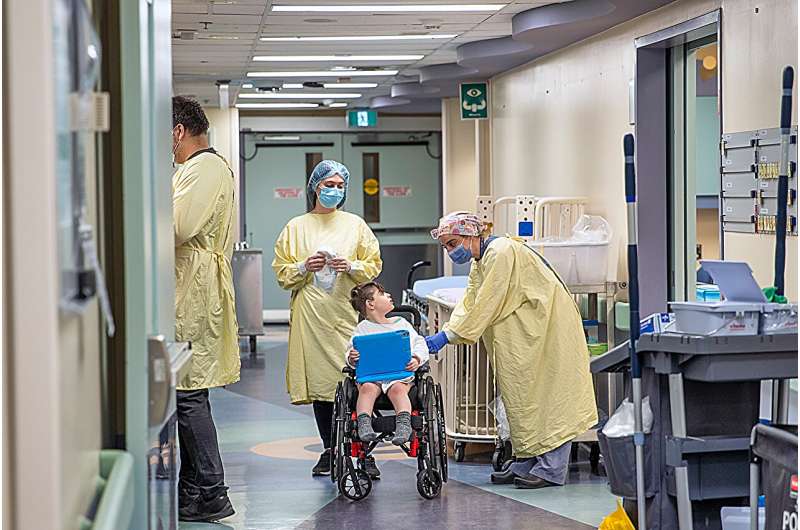This article has been reviewed according to Science X's editorial process and policies. Editors have highlighted the following attributes while ensuring the content's credibility:
fact-checked
peer-reviewed publication
trusted source
proofread
Gene therapy halts progression of rare genetic condition in young boy

When Michael Pirovolakis received an individualized gene therapy in a single-patient clinical trial at The Hospital for Sick Children (SickKids) in March 2022, the course of his condition was dramatically altered.
Michael has spastic paraplegia type 50 (SPG50), an "ultra-rare" progressive neurodegenerative disorder that causes developmental delays, speech impairment, seizures, a progressive paralysis of all four limbs, and is typically fatal by adulthood. Approximately 80 children around the world are affected by this genetic condition.
In a bid to slow the progression of the condition, a clinical research team at SickKids administered a first single-patient gene therapy to Michael less than three years after his initial diagnosis.
Today, the groundbreaking clinical trial published in Nature Medicine documents Michael's journey in the 12 months following the procedure, along with the novel impact this trial holds for the future of genetic medicine in Canada.
What is gene therapy?
Gene therapy is a way of delivering a healthy copy of a gene into the cells of a person who has a faulty gene(s). In Michael's case, SPG50 is caused by two pathogenic variants in a gene called AP4M1.
Led by Dr. Jim Dowling, Staff Physician in the Division of Neurology and Senior Scientist in the Genetics & Genome Biology program at SickKids, the clinical research team delivered the healthy AP4M1 gene into Michael's spinal fluid, which carried the gene directly to the nerve cells.
"While these ultra-rare diseases are unique, our workflow provides a road map for gene therapies that could help many of the thousands of children in Canada with rare genetic conditions," says Dowling.
Thanks to a multi-center collaboration with doctors and companies in the U.S. and Canada to coordinate the research, development, and manufacturing of a gene replacement therapy, the team was, remarkably, able to administer the gene therapy treatment to Michael within three years of diagnosis.
Michael's journey
In the 12 months after he received the treatment, Michael experienced no serious side effects, and contrary to the hallmark of neurodegenerative conditions like SPG50, his condition does not seem to be progressing further.
He also began to show potential signs of improvement. For the first time, Michael was able to stand with his heels on the ground. He also experienced improvements in some aspects of his neurodevelopment.
"When we heard that Michael had been diagnosed with this terrible disease, our world fell apart. We were lost and broken as a family," says Michael's parents, Terry and Georgia. "Thankfully, we had an amazing team at SickKids and a supportive community that lifted us up and gave us the confidence to raise millions of dollars and create a therapy, not only for Michael, but for other children affected by this disease for generations to come."
The future of gene therapy in Canada
The clinical research team continues to follow Michael's progress, but the trial provides important initial evidence of the safety and efficacy of gene therapy to reduce or halt the progression of SPG50.
Importantly, the results also highlight how gene therapy can be developed quickly and personalized for individual patients with rare genetic conditions. They hope that this approach can be used for other conditions in the future to help achieve Precision Child Health, a movement at SickKids to deliver individualized care for every patient.
"There are over 10,000 individual rare diseases and most are without therapy," says Dowling. "We are providing a blueprint that with adequate funding and support, has the potential to change the lives of patients with rare diseases and a future where every child can benefit from precision medicine."
More information: AAV gene therapy for hereditary spastic paraplegia type 50: a phase 1 trial in a single patient, Nature Medicine (2024). DOI: 10.1038/s41591-024-03078-4




















